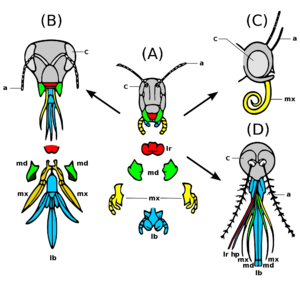Mouthparts facts for kids
Mouthparts are the special tools animals have around their mouths. They help animals grab, chew, or drink their food before swallowing it. Think of them like forks, spoons, or straws that animals use! Almost all animals have mouthparts. The only exceptions are very simple animals that soak up their food directly through their skin.
Contents
What Are Mouthparts?
Mouthparts are the parts of an animal's body that are found around its mouth opening. These parts are super important for how an animal eats. They can be very different from one animal to another. For example, a shark's mouthparts are very different from a butterfly's!
Why Are Mouthparts Important?
Animals use their mouthparts to get food into their bodies. Without the right mouthparts, an animal might not be able to eat the food it needs to survive. Over millions of years, animals have developed many different kinds of mouthparts. Each type is perfect for the kind of food the animal eats.
Different Types of Mouthparts
There are many ways animals eat, and their mouthparts show this. Some animals chew their food, while others suck liquids. Some even dissolve their food outside their bodies! Let's look at some common types.
Chewing Mouthparts
Many animals have mouthparts designed for chewing. These are often strong and can cut, crush, or grind food.
- Insects: Insects like grasshoppers, beetles, and cockroaches have chewing mouthparts. They have strong jaws called mandibles that move sideways. These mandibles are great for biting off pieces of plants or other insects.
- Mammals: Most mammals, like humans, dogs, and cows, have teeth that act as chewing mouthparts. Our front teeth (incisors) cut, and our back teeth (molars) grind.
Sucking Mouthparts
Some animals have mouthparts that are like straws. They use these to suck up liquid food.
- Butterflies and Moths: These insects have a long, coiled tube called a proboscis. It's like a flexible straw. When a butterfly wants to drink nectar from a flower, it unrolls its proboscis and sips the sweet liquid.
- Mosquitoes: Female mosquitoes have a special sucking mouthpart that can pierce skin. They use it to suck blood, which they need to lay their eggs.
- Flies: Some flies, like houseflies, have a soft, spongy mouthpart called a labellum. They dab it onto liquid food and then suck it up.
Lapping Mouthparts
Lapping mouthparts are used to soak up liquids, often with a tongue-like structure.
- Bees: Bees have a tongue-like structure that they use to lap up nectar from flowers. They also have mandibles, but these are mostly for handling wax or pollen, not for chewing food.
- Cats and Dogs: When your pet drinks water, it uses its tongue to scoop up the liquid into its mouth. This is a form of lapping.
Piercing and Sucking Mouthparts
These mouthparts are a combination. They first pierce something, then suck out the liquid inside.
- Aphids: These tiny plant-eating insects have a needle-like mouthpart called a stylet. They push it into a plant stem and suck out the plant's sap.
- True Bugs: Many insects known as "true bugs" (like stink bugs or cicadas) also have piercing-sucking mouthparts. They use them to feed on plant juices.
Animals' mouthparts are amazing examples of how living things adapt to their environment and their diet. Each type is perfectly suited for getting the right kind of food!


